"A propaganda film, made in the early days of the Second World War. Opening with footage of a giant Empire Youth Rally at Brockton Point Oval, the film illustrates Canadian democratic values, institutions and ideals which are now threatened by fascism and war -- farming, industry, the home and family, education, racial tolerance, elections, and religious freedom. Also includes footage of First World War memorials in Vancouver and Victoria, cemeteries, Remembrance Day ceremonies and parades, and veterans. Canada's contribution to the war effort is shown through shots of recruiting stations, marching recruits, military parades, warships, etc. One lengthy sequence uses model airplanes, dramatizations, stock shots, photographs, and footage of local civil defence drills to simulate the impact of aerial attacks on British cities during the Blitz (including civilian casualties and damaged or burning buildings)" British Columbia Archives.
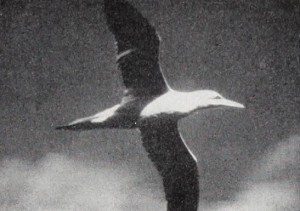
"In one sense, the outstanding strength of The Gannets, Maxim Award winner for 1950, is its seemingly worst weakness. That strength is the unquestioned — but apparently accidental — entertainment which the film provides. Running a brief 400 feet of 16mm. color, the picture examines the famous gannet colony on Gaspe's Bonaventure Island, treating the giant birds with lighthearted good humor and casual unpretension. The entire accomplishment seems too easy. You could do it, you feel, over a single sunny weekend. But don't let this fool you. To begin with, there is the technique. In The Gannets, Warren Levett has employed with a knowing skill every technical artifice learned in long years of bird filming. Telephoto lenses present his gleaming subjects in crisp and astounding closeups. The follow shots of birds in flight are suave and invariably centered, while slow motion reveals arrestingly their superb aero-dynamics. Side and back lighting enhance repeatedly the natural beauty of the birds, aided on occasion by a shrewd use of the polaroid filter. Secondly, there is the subject matter treatment. Pictorially, Mr. Levett knows his way around a sequence with unerring instinct. He knows, too, the strength which lies in a pair of shears; his editing of a subject so often overladen by the amateur is incisive and refreshing. And, perfectly interwoven with the pictorial presentation, is the third strength of The Gannets — the delight of the picture's narrative. You learn things about gannets as you listen — but they're not long-winded nor in Latin — and you're scarcely conscious of the learning. What you are conscious of is that the gannet is a strange, gabby, beautiful and, sometimes, supremely ludicrous creature. You are, in a word, entertained as you are informed — and you love every light-hearted minute of it. It is only later, if at all, that you realize the true measure of this superb movie." Movie Makers, Dec. 1950, 446-447.
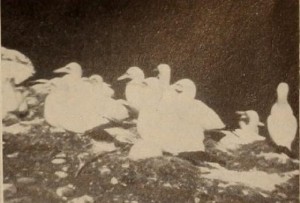
"Gannets are treated exhaustively and other aspects of life on Gaspe lightly in W. A. Levett's Gaspesia, a sound and often informative study of this tiny Canadian community. Mr. Levett has his Kodachrome under crisp control, and the strong textures in many of his sequences lend authenticity to a generally able film. The life of the gannets is admirably handled, though the time devoted to them tends to give the film a split personality." Movie Makers, Dec. 1949, 469.
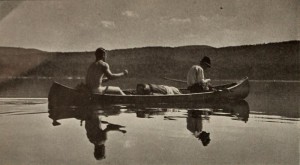
"The refreshing story of a voyage by river into the Canadian wilds, presented by F. R. Crawley in Glimpses of a Canoe Trip, is really deserving of a less modest introduction than that implied by the word, "glimpses." Here, within one reel, is as comprehensive a movie tale of a trip by canoe as one could desire. The entertaining continuity, based on the natural sequence of events, is not loaded with unimportant detail; instead, footage is conserved for the more interesting episodes involved in paddling and portages. These are given a well rounded treatment that has genuine entertainment value coupled with a freshness of approach born of the enthusiasm of the maker. This sort of thing communicates itself to the audience, especially when photography, editing and titling are as well handled as they are here." Movie Makers, Dec. 1937, 629.
"Record of a Woodley family trip to the Gaspé." Library and Archives Canada.
"U.S. President Franklin Delano Roosevelt and First Lady Eleanor Roosevelt visit Victoria on 30 September 1937" British Columbia Archives.
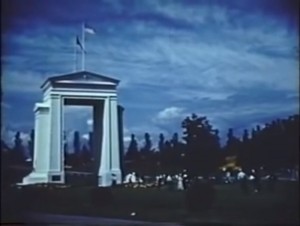
"Local sights and events in the White Rock area, such as parades, celebrations at the International Peace Arch, fashion show, recreational activities, etc." British Columbia Archives.
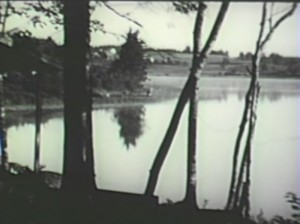
"Film documenting a gathering of guides from all over Canada meeting at [Lake William], N.S. Shown are the many events and competitions in which the guides partake including canoe portage, fly casting, canoe tilting, log burling and canoe racing." Nova Scotia Archives.
Total Pages: 12